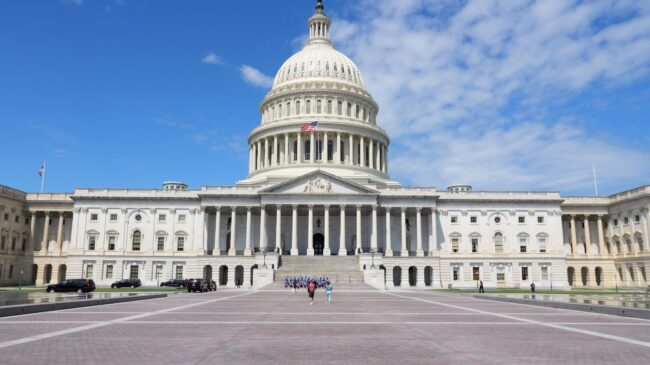With Congress considering approving an additional $726 billion in federal education spending as part of the proposed $3.5 trillion reconciliation bill, policymakers should first consider how K-12 schools have allocated the recent surge of emergency funds that states have received in response to the COVID-19 pandemic.
At the end of last school year, states had not yet spent $143 billion of the funds nearly $200 billion appropriated for K-12 purposes through three pandemic stimulus and relief bills — the Coronavirus Aid, Relief, and Economic Security Act (CARES Act) signed in March 2020 and the Dec. 2020 Coronavirus Response and Relief Supplemental Appropriations Act (CRRSAA) signed by then-President Donald Trump, and 2021 American Rescue Plan (ARP) signed in March 2021 by President Joe Biden.
While it currently seems unlikely to pass the House and Senate at its full $3.5 trillion size, the proposed reconciliation bill’s K-12 spending would be more than triple the amount provided for K-12 education via the three previous COVID-19 relief packages combined.
Historically, education has largely been funded at the state and local levels. Before Congress further enlarges the federal government’s K-12 funding footprint, policymakers should ensure that state education agencies and local education agencies need the money and are complying with all federal reporting requirements. The CARES Act and CRRSAA awarded state and local education agencies more than $150 billion in funds through the Elementary and Secondary School Emergency Relief (ESSER), which has important reporting requirements to ensure transparency and to track how education dollars are being used.
Currently, the federal reporting system does not comply with the comprehensive reporting requirements of the CARES Act and fails to provide detailed accounts of how ESSER dollars were spent. The CARES Act requires state education agencies to provide quarterly reports to the U.S. Department of Education and Pandemic Response Accountability Committee (PRAC) showing:
- The entire amount of CARES Act funds received from the agency;
- How much of those funds were obligated or outlaid on specific projects or activities;
- Detailed accounts of every project or activity, specifically, the project’s name, description, and the number of jobs preserved or created by each project; and
- Comprehensive accounts of all subcontracts or subgrants awarded by state education agenices to comply with all requirements under the 2006 Federal Funding Accountability and Transparency Act (FFATA).
Last year, U.S. Office of Management and Budget (OMB) guidance incorrectly informed states that the existing reporting requirements under FFATA completely fulfill their CARES Act’s ESSER reporting requirements. FFATA requires federal agencies to post data about award spending at USASpending.gov to ensure transparency and accountability for taxpayer dollars.
Unfortunately, FFATA reporting falls short of key reporting requirements under the CARES Act since the OMB guidance ignored the CARES Act’s recipient reporting requirements that provide detailed tracking of how funds are used.
“Data reported on USASpending.gov does not include data reported by recipients of federal funds and therefore would provide no details on specific projects or jobs created using coronavirus relief funds,” Sean Moulton from the Project on Government Oversight explained.
This discrepancy also affects ESSER dollars provided through the CRRSA Act, which is bound by the same reporting requirements as the CARES Act. The OMB guidance directly contradicts federal reporting requirements which will prevent the PRAC from completing its analysis of how federal funds were used.
To make matters worse USASpending.gov, the public’s virtual resource for federal spending, has been plagued by widespread errors for years. A 2018 report by the Project on Government Oversight indicated that the website regularly suffered from display errors, duplicate transactions, and poor expense descriptions.
Despite the report’s findings, many of the website’s discrepancies remain unresolved. For instance, New Jersey distributed $257 million in ESSER funds to 599 sub-awardees under the opaque description “Emergency Relief.” Similarly ambiguous descriptions appear for New York and Michigan’s ESSER spending.
Not only do these vague descriptions fail to comply with federal law, they also make it difficult for policymakers to analyze how funds were used.
Policymakers should pursue reforms that ensure federal COVID-19 relief spending is accurately reported, especially since ESSER funds remain largely unspent. According to the American Enterprise Institute’s Nat Malkus, 29 state ARP reports indicated that on average only 19% per reporting states of ESSER funds provided in 2020 were spent as of June 2021.
Two reforms could vastly improve transparency and accountability of federal COVID relief spending, including ESSER:
First, the Department of Treasury should ensure that the descriptions on USASpending.gov clearly illustrate the purpose and impact of federal spending. Specifically, the website should make public full award documents and statements of work, data showing how the recipients used the federal funds, past performance reviews, and any other data that can show taxpayers and policymakers if the money was spent effectively.
For instance, showing how many school children benefit from ESSER dollars used to purchase personal protective equipment or fund after-school learning programs to mitigate pandemic-induced learning loss could provide a more nuanced picture of spending efficacy.
Additionally, the Office of Management and Budget and the Department of Treasury should track federal emergency funds through a separate federal system which would allow clear and consistent standards, which would help to eliminate waste, fraud, and abuse. The cumbersome nature of USASpending.gov often undermines its intended purpose: transparent federal spending.
As Congress considers pouring even more federal money into K-12 education, policymakers should guarantee that robust accountability structures to track federal education spending exist. Taxpayers need to be able to hold lawmakers accountable for these massive spending decisions. States and school districts also need to be held accountable for ensuring federal COVID-19 funds actually make their way to classrooms and programs benefitting students.

